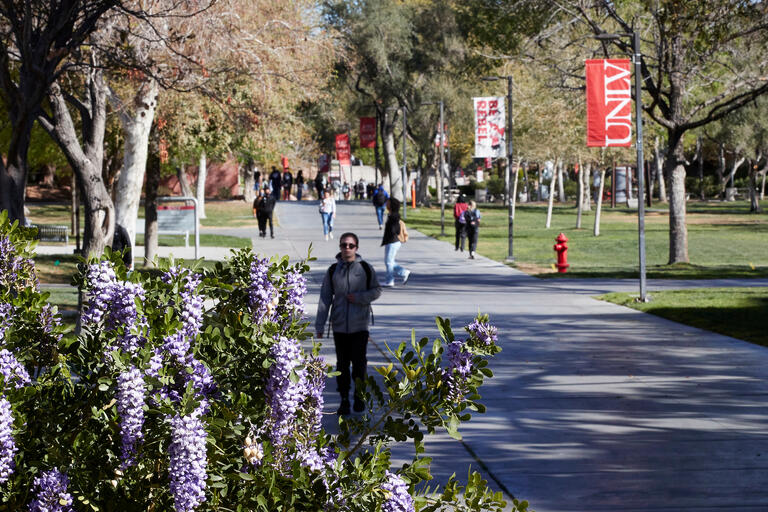Las Vegas is 9,627 miles from Seoul, South Korea, but 1,820 miles closer than Duke University. Good news for June Cho, associate professor at UNLV School of Nursing. Along with the allure of dry weather and the relaxing living conditions for her husband’s retirement, the pursuit of biobehavioral child development nursing research and living closer to family in South Korea and her many friends in the West brought Cho to Southern Nevada and UNLV.
The career high of gaining an “a-ha” moment when she identified testosterone as a potential biomarker of male infant development issues, accompanied by sightseeing in Las Vegas, makes her a happy Nevadan.
Your biggest misconception about Las Vegas before you arrived
I’ve been living in the eastern United States for more than 20 years and I’ve always been curious about life in the West. Las Vegas has been known as “Sin City.” This nickname is indeed unfair! Another misconception about Las Vegas is that there won’t be many opportunities to appreciate nature, but I’ve found lots of outdoor places to see and visit.
What you are passionate about in addition to your research
Daily walking and sightseeing around town. Visiting families and friends in California and Arizona. Also, finding good restaurants in Las Vegas makes me so happy.
An “a-ha” moment in your career
When I identified testosterone as a potential biomarker of health and developmental issues in male infants. It was a great “a-ha” confirmation moment that I’ve been working on a very significant approach; examining and confirming male vulnerability especially among very-low-birthweight (birthweight <1,500gm) preterm infants.
At the end of my Ph.D. dissertation (at University of North Carolina – Chapel Hill), I realized the importance of general theories of gender-differences and the theory of extreme male brain autism. The clinical findings and literature have shown that boys are more likely to be born prematurely, have higher rates of mortality and morbidity, and have more developmental delays than girls during early childhood. Gender is a broad concept for examining the differences between males and females. I used testosterone as a possible biological factor that could explain male vulnerability beyond gender. According to these theories, exposure to elevated prenatal testosterone levels is a biological risk factor for the brain, and neurodevelopment.
As the end products of hypothalamic-pituitary-gonadal (HPG), and hypothalamic-pituitary-adrenal (HPA) axes, testosterone and cortisol are very similar in hormonal cascades, involved in stress regulation, and produced partially from the adrenals. I’ve used both steroid hormones to examine the associations between hormonal biomarkers for infant health, mother-infant interactions, and infant development up to 24 months corrected age for prematurity.
And another “a-ha” moment...
Was when I found that testosterone is more predictive for infant outcomes than cortisol, although cortisol has been widely used as a stress hormone affecting infant outcomes. Recently, I also found that testosterone is a better predictor than cortisol for maternal mental health problems such as depressive symptoms, and anxiety, as well as unhealthy lifestyle behaviors such as smoking and alcohol abuse. Those maternal outcomes were related with maternal demographic factors and the levels of testosterone, but not cortisol.
Is this what you thought you’d do when you grew up?
Yes. I’ve always enjoyed studying. Nowadays, disseminating our research outcomes has been the major joy.
What was your greatest day on campus? And your toughest?
The day I finally completed moving into my office. I’ve been at UNLV for less than one year so I don’t have much to tell about my greatest and toughest days yet. I am looking forward as a researcher to receiving a new research grant. It will be the greatest day during my tenure on campus.
What research of yours do you think deserved more attention?
Research related to preterm birth. This is an important public health issue. Especially in the U.S. because of our high rates of preterm and low birthweight. The rates of preterm and low-birthweight birth in the U.S. are higher than 27 other countries even though the U.S. has been spending more than 2.6 billion dollars annually for the treatment of preterm infants. Improving the cognitive, motor, language, and socioemotional development of infants is a great challenge. It not only affects families, but also our society and global population.
What’s your lesson learned in the lab/field?
Human resources are really important in becoming a successful researcher. The principal investigator cannot accomplish everything alone. Institutional support and encouragement are also highly desirable.
What advice would you give your younger self back when you lived in Korea?
Don’t be afraid, you can do it. Do your best and then have no regrets.
Is the start of fall semester more or less exciting than the end of spring semester?
I get more excited at the start of a new school year. For me, it’s another opportunity to help new students improve their professional careers through the courses I teach. Farewells are always sad and more difficult for me than meeting new students.
What is the most "Western" experience you have had since moving to Las Vegas?
The culture and pride of Las Vegas, the diversity and hospitality I feel living in a worldwide tourist destination. The people I've met here are so friendly to me and there is such a pioneering spirit where everyone has an opportunity. I love the dry comfortable weather and world-class of entertainment including city life and country life. People in the West appear to be conservative for keeping clean air and nature. I've loved the western weather and bug-free living of Las Vegas beginning on my first day.
Best tip for someone new to UNLV
Stay inside during your first summer. You will adapt to the hot summer days. At UNLV you have a lot of opportunities to be a successful teacher, researcher, and clinician. Do your best and you will find your way.



